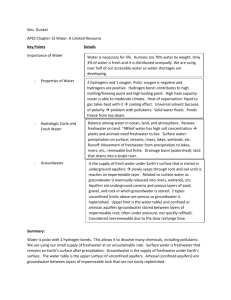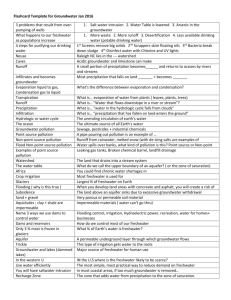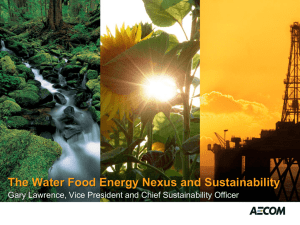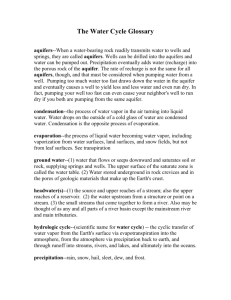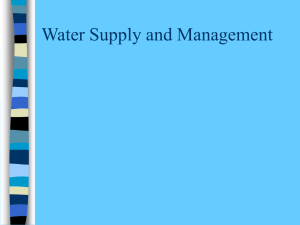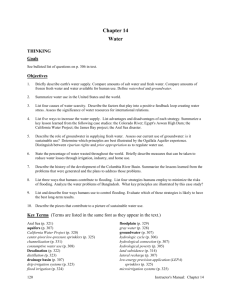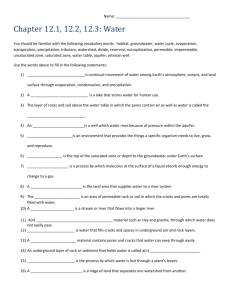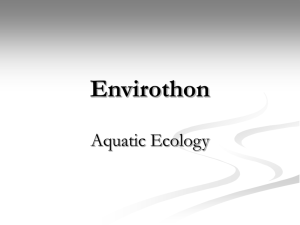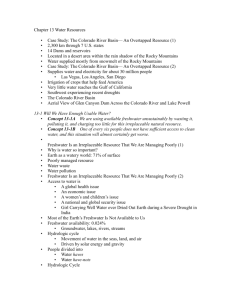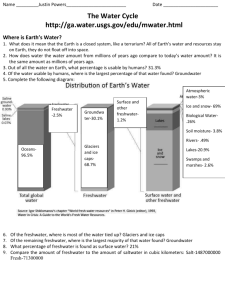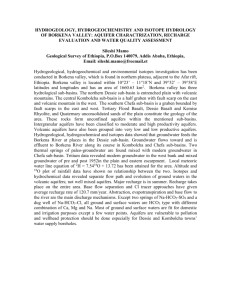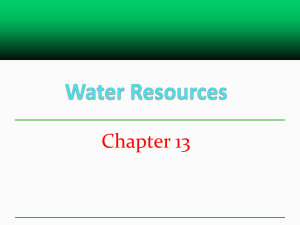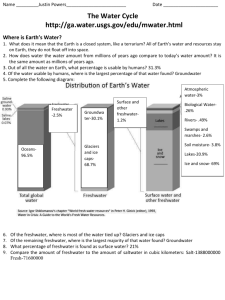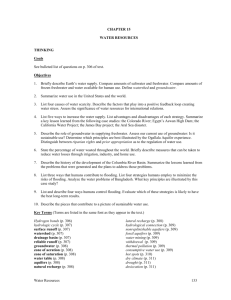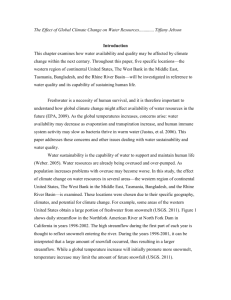Chapter 13 outline - Doral Academy Preparatory
advertisement
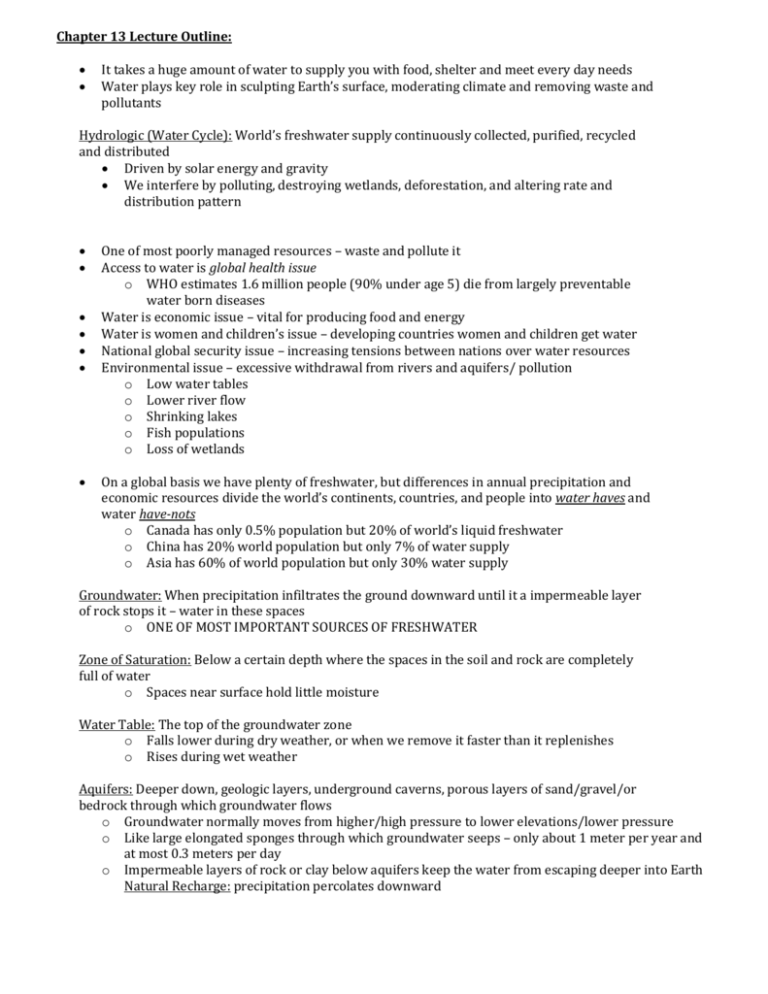
Chapter 13 Lecture Outline: It takes a huge amount of water to supply you with food, shelter and meet every day needs Water plays key role in sculpting Earth’s surface, moderating climate and removing waste and pollutants Hydrologic (Water Cycle): World’s freshwater supply continuously collected, purified, recycled and distributed Driven by solar energy and gravity We interfere by polluting, destroying wetlands, deforestation, and altering rate and distribution pattern One of most poorly managed resources – waste and pollute it Access to water is global health issue o WHO estimates 1.6 million people (90% under age 5) die from largely preventable water born diseases Water is economic issue – vital for producing food and energy Water is women and children’s issue – developing countries women and children get water National global security issue – increasing tensions between nations over water resources Environmental issue – excessive withdrawal from rivers and aquifers/ pollution o Low water tables o Lower river flow o Shrinking lakes o Fish populations o Loss of wetlands On a global basis we have plenty of freshwater, but differences in annual precipitation and economic resources divide the world’s continents, countries, and people into water haves and water have-nots o Canada has only 0.5% population but 20% of world’s liquid freshwater o China has 20% world population but only 7% of water supply o Asia has 60% of world population but only 30% water supply Groundwater: When precipitation infiltrates the ground downward until it a impermeable layer of rock stops it – water in these spaces o ONE OF MOST IMPORTANT SOURCES OF FRESHWATER Zone of Saturation: Below a certain depth where the spaces in the soil and rock are completely full of water o Spaces near surface hold little moisture Water Table: The top of the groundwater zone o Falls lower during dry weather, or when we remove it faster than it replenishes o Rises during wet weather Aquifers: Deeper down, geologic layers, underground caverns, porous layers of sand/gravel/or bedrock through which groundwater flows o Groundwater normally moves from higher/high pressure to lower elevations/lower pressure o Like large elongated sponges through which groundwater seeps – only about 1 meter per year and at most 0.3 meters per day o Impermeable layers of rock or clay below aquifers keep the water from escaping deeper into Earth Natural Recharge: precipitation percolates downward Lateral Recharge: from the side by nearby rivers/streams o Recharge tends to be VERY SLOW o Urban/paved areas Nonrenewable Aquifers: get very little/no recharge. Found deep underground and formed tens of thousands of years ago o This is like mining non-renewable resource o Unsustainable use of this resource Surface Water: freshwater from precipitation and snowmelt that flows across Earth’s land surface and into rivers, streams, lakes, wetlands, and ultimately to the ocean Surface runoff: Precipitation that does not infiltrate the ground or return to the atmosphere by evaporation o Surface water replenished by runoff is classified as a renewable but finite resource Watershed/Drainage Basin: The land from which surface water drains into a particular river, lake, wetland, etc. Reliable Surface Runoff: The remaining 1/3 of runoff not lost for human use by seasonal floods (2/3) o Amount of surface runoff that we count as source of freshwater During the last century human population tripled – global water withdrawal increased sevenfold, per capita withdrawal quadrupled We now withdraw 34% of World’s reliable surface runoff o Estimated: by 2025 global withdrawal to 70% o Even 90% if per capita withdrawal continues increasing at same rate o Arid American Southwest – 70% of reliable runoff is withdrawn for humans o Unsustainable as ecological footprint 70% of water we withdraw is to irrigate cropland 20% Industry 10% cities and residences Affluence vs. poverty Case Study: US: Drought: prolonged period in which precipitation is at least 70% lower and evaporation is higher than normal in an area that is normally not dry Arid/semi-arid regions – irrigation accounts for 85% of water use A good portion is unnecessarily wasted Almost ½ water used comes from groundwater o The rest rivers, lakes, reservoirs Water tables lowering Excessive drainage from aquifer near a river/stream can decrease or deplete surface water o When water table drops below the level of the stream, its water drains into aquifer 36 US states likely to face water shortages by 2013 Water Shortages will grow: UN estimates by 2025 at least 3 billion of the projected 7.9 billion people will lake access to safe water Hydrological poverty in arid/semi-arid areas o Flood of refugees can cause intense conflict –Middle East Ogallala aquifer: largest known aquifer Supplies 1/3 of all groundwater used in US Great Plains agriculture Very slow recharge Southern States aquifer is thinner and water being depleted rapidly o Texas-Oklahoma Loss of wetlands – loss of biodiversity Groundwater withdrawal near coastal areas can lead to salt water intrusion Reservoir: Artificial body of water created by damming river Look at positives and negatives for building dams/reservoirs Case Study: The Colorado River Basin— an Over tapped Resource Water mostly from snowmelt from the Rocky Mountains Desert area with rain shadow 14 major dams and reservoirs and canals that support water to farmers, ranchers and cities Water and electricity for more than 25 million people in 7 states Area produces about 15% nations crops Major cities – Las Vegas Nevada, California, Arizona Recreation – white water rafting, boating, fishing, hiking, camping (multibillion dollar industry) Lake Mead – 90% for Las Vegas By 2021 Lake Mead could run dry – decreased flow and greater demand for water Amount of water flowing to the mouth of the river has dropped Decreased sedimentation (fertile) loss of coastal wetlands California Water Project: Water Transfer: uses maze of giant dams, pumps, and aqueducts to transport water from water rich Northern California to water poop Southern California To areas that would otherwise be mostly desert Southern CA wants more water for crops Northern CA says sending more water will degrade Sacramento River and fisheries Making irrigation more effective to prevent water loss? Low water prices from government subsidies deter farmers from investing in better technologies Desalination: removing dissolved salts from ocean water/brackish water in aquifers or lakes for domestic use Distillation – heating saltwater until it evaporates then condenses again Reverse Osmosis (microfiltration) – uses high pressure to force salt water through membrane filter 15,000 plants in 125 countries – mostly in Middle East Saudi Arabia has world’s largest number of desalination plants By 2008 Israel has been getting ½ of its water from desalination Distillation requires 10x as much energy as reverse osmosis Use of chemicals to sterilize water Wastewater with a lot of salt and other minerals – dumping increases salinity of ocean Problems – only works for water-short wealthy counties Using desalination for crops – removes salts – but also beneficial ions Ca, Mg

